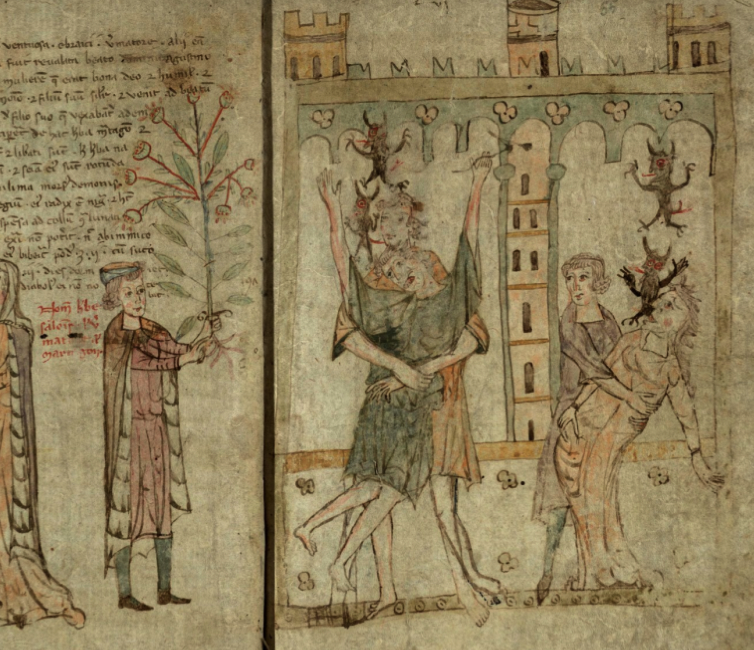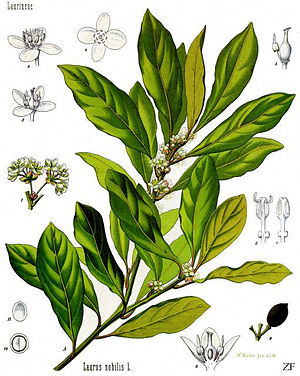It’s a delight to look through old herbal manuscripts, especially those with text that describes the plants and their uses. Even if the language and style of script are unfamiliar (and heavily abbreviated), that’s part of the fun—you get to be a detective.
Trinity College MS O.2.48, for example, is full of intriguing details. Created a century or so before the Voynich manuscript, it includes more than 300 herbal images. Some plants are recognizable and others take effort to decipher, even when names are provided in several languages. Fortunately, the Web is full of resources to help us unravel the identifications.
MS O.2.48 parallels Plut.73.Cod.16 (Biblioteca Medicea Laurenziana) in many ways, which means the two can be enjoyed side-by-side while sorting out some of the more puzzling imagery.
They are not exact copies, the two manuscripts differ in drawing style and page layout—Plut.73 is more heavily and evenly painted, and the plants are more stylized and symmetric, as can be seen in these examples:
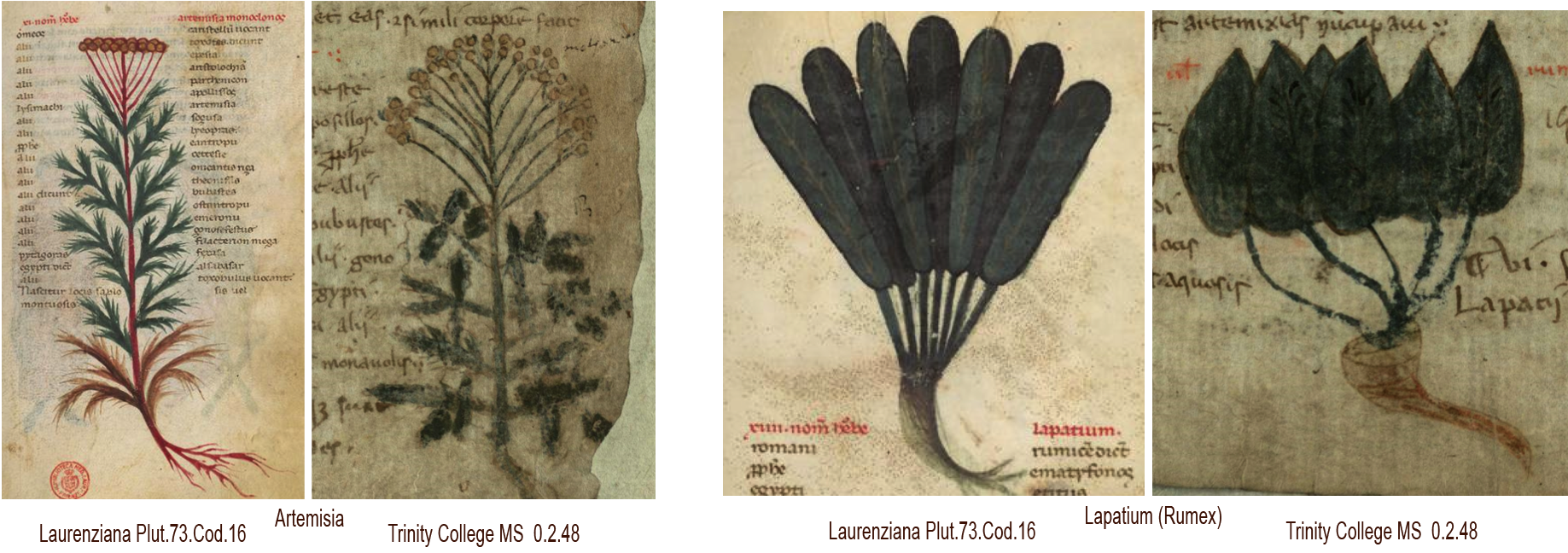
The Plutei and Trinity College manuscripts differ in drawing style, layout and content, but include many parallels that can help sort some of the less obvious plant IDs.
Highlights
MS O.2.48 was created sometime in the 1300s at an uncertain location. In addition to images of herbs, there are scenes about how herbs were used. For example, on folios 54v and 55r, herbe salomonis is held aloft by an important figure to help him exorcise the demons to the right:
At the top of the scene is something of particular interest to Voynich researchers, V-shaped crenellations called swallowtail merlons, similar to those on the rosettes foldout in Beinecke 408. This architectural style was associated, in earlier centuries, with the Ghibellines, supporters of the Holy Roman Empire, who were at political odds with those who supported the pope in Rome. Swallowtail merlons have become decorative elements since that time, but in the 14th and 15th centuries, they were still emblems of a long-standing power feud between the loyalists and the papists.
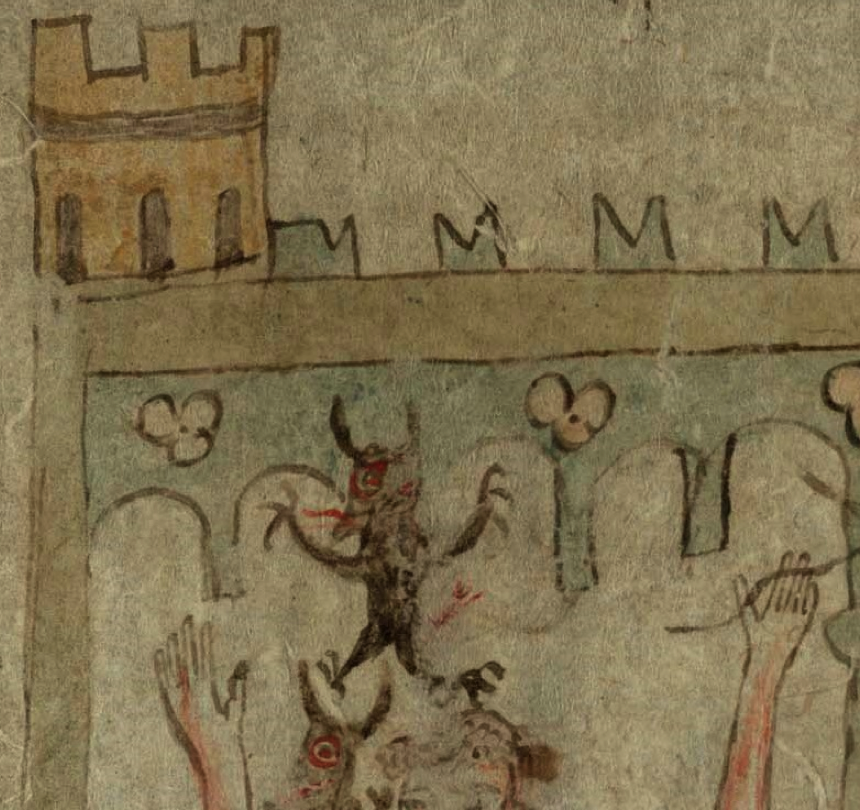 So what exactly do those merlons signify in a section devoted to herbs? Do they reveal the political leanings of those who created the manuscript? Or were the creators contemptuous of attempts to establish power centers outside of Rome? Or are they saying that supporters of the emperor are heretics in need of herbal “therapy”?
So what exactly do those merlons signify in a section devoted to herbs? Do they reveal the political leanings of those who created the manuscript? Or were the creators contemptuous of attempts to establish power centers outside of Rome? Or are they saying that supporters of the emperor are heretics in need of herbal “therapy”?
The text to the left of the plant gives us a clue. It identifies the man holding the plant as “beat[us] augustin[us] and describes a brief legend of the saint and the martagon plant (also labeled salominis, ventriosa/ventuosa, and vermatore). Thus, St. Augustine, who was born in Algeria and served as bishop of the region before traveling to northern Italy, was chosen to administer the rights. St. Augustine is an important symbol of the Catholic church and thus would be considered by papists as an appropriate emissary for wielding herbal power.
The provenance of MS O.2.48 is uncertain, but it’s thought it may have been created in Germany. The Ghibelline merlons suggest that if it is Germany, it’s probably southern Germany or Lombardy (which is now part of northern Italy). Lombardy was much larger in the middle ages, with an interesting blend of cultures (Scandinavian, German, Italian, and Bohemian) and was known to have a number of illumination studios. Sloane 4016 (mid-15th century) is one of the best-known herbal manuscripts created in this region.
On the Trail of the Martagon
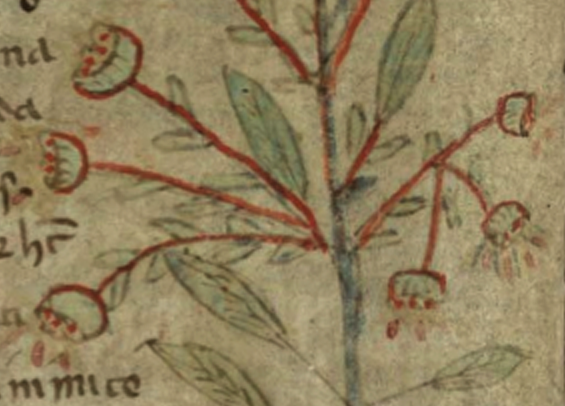 Thus, the drawing reveals something about those who created the manuscript, but the label next to the plant is hard to reconcile with the plant itself. Most of the Trinity MS plant illustrations are reasonably naturalistic, but this plant doesn’t resemble the martagon lily (aka Turk’s cap lily) in any way—the roots, leaves, and flowers are all wrong.
Thus, the drawing reveals something about those who created the manuscript, but the label next to the plant is hard to reconcile with the plant itself. Most of the Trinity MS plant illustrations are reasonably naturalistic, but this plant doesn’t resemble the martagon lily (aka Turk’s cap lily) in any way—the roots, leaves, and flowers are all wrong.
A closer look at the flowers shows red droplets. Is this a reference to sap or perhaps to blood? There are a number of plants with red sap, but most of them don’t look like this. The alternate names aren’t helpful either. ventuosa/ventriosa, and vermatore/virmatore aren’t easy to reconcile, many old plant names have been lost, but Salonis/Salomonis might be helpful. There are a number of plants that go by this name, which is an ancient reference to King Solomon.
The most well-known plant associated with the name is Sigillum salomonis, or Solomon’s seal, due to the round seal-like scars on the plant’s knobby roots. Unfortunately, its distinctive bell-like white flowers dangling from one side of the stem don’t look like the plant in Trinity O.2.48.
Verbena was once called “tears of Isis” and was later adapted into the Christian religion as the herb that was placed on Christ’s wounds. This might explain the red droplets, but Verbena is already represented in the Trinity MS by a drawing that more closely resembles the actual plant. The herbs in the Nine Herbs Charm didn’t provide any close matches either. Mugwort fits the context, but the flowers are spikes and the leaves are deeply serrated.
Bishop’s wort (Stachys officinalis) is an ingredient in remedies to exorcise demons. It has elliptical leaves but doesn’t closely match the flowers, and doesn’t explain the red droplets, but it’s closer to the drawing than plants called “martagon” or “Salomonis”, and fits the context.
Summary
I considered that the plant might be St. John’s wort (Hypericum), which has elliptical leaves, red sap that appears when the leaves are pounded, and fuzzy yellow flowers that change to a berry-like fruit. It is said to provide protection against demons, but it doesn’t appear to have a strong connection to exorcisms, and the plant in Trinity O.2.48 is quite large, larger than one might expect Hypericum to be drawn.
The best candidate I’ve found so far, and I’m not certain it’s the right one, is Laurus nobilis, known as sweet bay. Laurel is a large shrubby plant with elliptical leaves and clusters of yellow flowers that point in various directions and change to small black fruits. It was a healing herb with the power to exorcise demons. In the 19th century, Parkinson writes: “It serveth to adorne the house of God, as well as of man; to procure warmth, comfort, and strength…” Northcote notes in 1903 that the Romans called it “the Plant of the Good Angell” and that it was used, in Rome, to “trim up their Churches and Monasteries on Solemn Festivals…” So Laurus nobilis has a strong connection to the Christian church consistent with the legend of St. Augustine.
So perhaps sweet bay is the puzzling plant and perhaps not. As far as Voynich research goes, a number of detractors have used the difficulty of identifying the VMS plants as a rationale for calling the VMS a hoax, but Trinity O.2.48 demonstrates that a plant can be clearly drawn and labeled, and even include allegorical imagery to explain it further, and still be a challenge to unravel.
J.K. Petersen
Postscript: After I wrote this blog, I became aware of M. Ponzi’s translation of the story of St. Augustine in the Trinity MS text. You might enjoy reading the story so I have added a link here.
© Copyright 2017 J.K. Petersen, All Rights Reserved

